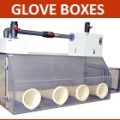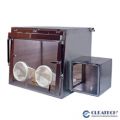Which Filtration Glove Box should you choose for your laboratory?

After understanding the features of a glove box, it will help you to select the right equipment for your laboratory. Basically, these are sealed containers that are designed for an individual to manipulate chemicals. They are customised for a separate set of environments that is required to complete the experiment.
The glove box is composed of a closed circulatory system, along with the bowler set-up and a gas purification system. The entire module shows that water and oxygen are kept at a requisite level throughout. If you work in a laboratory, then to ensure safety while handling reactive chemicals, the filtration glove boxes provide an inert atmosphere.
Some even come with inbuilt monitoring software, automatic purging and highly accurate sensors. The gloves are kept in the box for easy to use, safe to run and cheap to buy system.
What Is Filtration Glove Boxes?
Filtration glove boxes use HEPA and ultrafiltration procedures. This enhances the necessity of protection of the product and the user safety by eliminating hazardous airborne particles from the protective enclosure.
Fields, where these Filtration glove boxes are required, are —
- Organic electronics technology
- Additive manufacturing pharmaceuticals
- Biological research
- Material handling
- Nanotechnology and biochemistry.
These are often referred to as potent compound barrier isolators, or hazardous toxic contaminate isolators. You can easily use microorganisms, chemicals, carcinogens, asbestos and low-level radiochemical for your experimentation. Filtration glove boxes are the most appropriate for handling compounds assigned ISO 4 and ISO 5 banding levels.
How are Filtration glove boxes different from other glove boxes?
Filtration glove boxes are quite different from the others because it has an open loop airflow system that controls the laboratory's particulates. It has HEPA or ULPA filters that capture the particles and maintain the environmental condition.
Filtration glove boxes are negative pressure and have particulates inside the chamber. The particulars include aerosols, pharmaceutical powder, microbial contaminates, which are captured through the filters. To make it is safe indoor, release the filter, i.e., HEPA and ULPA remove contaminants from the exhaust gas. They can isolate sterile objects inside from outside particles.
If you want to control 100% humidity and oxygen level, then filter gloves won't be on your list of choices. Because these glove boxes are not designed to maintain a pure gas atmosphere.
What is Filtered glove boxes made of?
Filtered glove boxes are made up of clear acrylic chemical-grade static material, acrylic, clear PVC and white polypropylene with tempered glass. If there is one operator, then 2 port gloves boxes are used, and 4 port glove boxes are used for two operators.
Filtration glove boxes come with optional accessories, including air pass-through transfer, chamber measures to minimise nitrogen loss and inflow of contamination. Based on the application and experiment that you are going to conduct, filtration glove boxes can be factory configured.
Different types of Filtration glove boxes based on the purpose of use
Glove boxes serve various purposes while using are filtered glove boxes. You need to check the voltage chamber material, window material, chamber (along with depth and height) and the number of glove spaces before starting the experiment.
Heated Filtration Glove Box
If your experimentation requires constant ambient temperature, then a heated filtration glovebox would be an ideal choice. These are easy to configure, available in closed as well as an open-loop filtration system. It has a constant program internal temperature set point for the introduction of large equipment.
Controlled Atmosphere Filter Glove Box
If you want to control the internal gas chemistry within the chamber, the valves must be used with a compressed inert gas tank. Opt for a controlled atmosphere filter glove box. To remove the internal gas mixture, it also has a vacuum pump. Thus, it helps to maintain higher flow movement. This setup also ensures that the moisture and oxygen concentration remain at the same level compared to the ambient laboratory atmosphere.
Static Dissipative Filter Glove Box
If you use the box for general purposes, then a clear acrylic gloves box can be used. But in case you are working on an experiment that requires the elimination of static charges in order to keep the box dry, then you can go for static dissipative acrylic manufactured box. These are much more powerful in chemical resistance than the general ones.
Conclusion
Every product used in the laboratory is not meant for technological development; some are also used to enhance the process of health care, cosmetics industry, food industry and commercial applications. So, if you are about to jump-start your research work that requires dealing with sensitive chemicals, you need to operate them through glove boxes. Thus, it can isolate the environment of the sample and the user.
Original Source: https://www.articleblock.com/which-filtration-glove-box-should-you-choose-for-your-laboratory/






